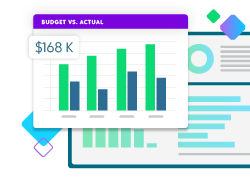The 7 Steps to Choosing Nonprofit Accounting Software

Software Advice works with hundreds of nonprofit professionals searching for new accounting software every year. This gives us insights into the challenges they face when researching products.
The bottom line—it’s overwhelming.
It takes time, energy and money to search for and compare nonprofit accounting software, and to implement a new system. The good news is that choosing the right solution can more than make up for that investment by saving money, increasing efficiency, and helping your organization build accountability and trust.
This checklist breaks the selection process into seven critical steps, and provides tips on how to choose the best software for your nonprofit.
1. Determine “Must-Have” Features
Gather feedback by talking to stakeholders who will use or support the software to find out their concerns and requirements. Encourage them to identify “must-have” and “like-to-have” features. Determine which features are requirements rather than just nice additions by asking questions such as “what would be the cost of not having this feature?”
Other considerations when choosing software with the best fit are:
- Is this software easy to use?
- Does this software integrate with our current technology and software programs?
- Does this software offer custom reporting options?
Don’t be afraid to get specific about your organization’s needs! This can help you separate one vendor from another and narrow down your product shortlist (which we will get to in a few steps).
2. Determine Technology Limitations and Requirements
If appropriate, have the IT team determine technology requirements and limitations. Other technology upgrades – such as servers, computers and internet service – may be required if existing equipment is very outdated. These upgrades need to be included when you are considering the total cost of implementing new software.
3. Consider Cost
One mistake to avoid is to budget only for the cost of the software license or subscription. There are additional costs associated with adopting new software, including implementation, training, and support costs. These costs are either bundled into the upfront cost or tacked on, so don’t forget to consider them when creating a budget. Calculate total cost of ownership to set a realistic budget that includes all costs related to implementing new software.
Remember to consider these common recurring fees when setting a budget:
- Subscription fees
- Training and support costs
- Maintenance and upgrades
Estimate the upfront cost and total cost of ownership difference between perpetual license and subscription-based systems, two common pricing models. With a perpetual license you purchase the software license outright, whereas with a subscription there is a recurring payment – usually recurring either monthly or annually – which you pay on an ongoing basis. Although the upfront investment for a perpetual license may be higher than that of the subscription-based model, the cost over time tends to be lower – rather than paying a subscription fee, you may be paying for services such as maintenance and support. Thus the total cost of ownership of the two models tends to converge over time, so, when choosing between the two pricing models, it’s really a matter of deciding whether you prefer the larger upfront investment or smaller upfront investment that repeats over time.
Fund Accounting Software that Drives Impact
Find out how Blackbaud’s Financial Edge NXT® fits your organization.

4. Create a Product Shortlist
Once you have your list of required features and your budget, create a shortlist of products that meet your requirements by doing some preliminary research online.
What you can do:
- Use Google to search for products.
- Read online product reviews and case studies.
- Review third-party product comparisons.
- Ask peer organizations for advice, tips and recommendations.
- Call a software adviser for a free consultation.
- Hire a technology consultant.
5. Watch Vendors’ Product Demos
Contact vendors to ask questions and schedule demos. Actually watching how the software operates is hugely important to your decision making process. Be direct with salespeople about the functionality you need to do your job (must-haves).
You can even ask vendors to put you in touch with some of their current customers so you can find out what benefits and challenges they have experienced.
6. Outline Expected Benefits, Possible Drawbacks
After demos are complete, meet with stakeholders to collect feedback on the pros and cons of each product.
Common benefits to consider:
- Keeps fund ledgers separate
- Helps you prioritize expenditures
- Supports documenting and tracking budget goals
- Simplifies tax preparation
- Bonus: accurate financial reporting reinforces trust in your organization
Outline possible drawbacks
Anticipating possible challenges is key to being able to deal with them effectively when – or if – they arise. Common issues that organizations face when implementing fund accounting software are:
- Decreased productivity during ramp-up period while staff learns the new product.
- Cost: while increased efficiency can save dollars, training, maintenance and upgrades can result in a net negative. To avoid this, calculate the total cost of ownership so there aren’t surprises when new software is implemented.
7. Make the Final Decision
After researching products and watching demos, meet with all stakeholders to collect feedback on the pros and cons of each product, then choose the solution that is truly the best fit. Sometimes the decision is easy and everyone agrees on which to choose. Hopefully this happens to you!
Other times, the choice isn’t so clear. There might be a great product that is missing one key feature or is just out of your budget. In that case, consider the cost of “settling,” and don’t be afraid to review other products. It might be better to search again than be stuck with a product that doesn’t meet your needs. So take your time, and don’t force a purchase that isn’t truly a fit for your organization.
